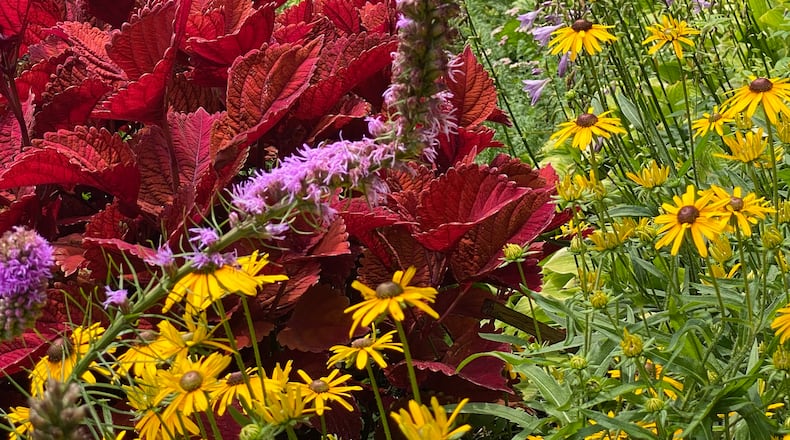Mann is one of six homeowners who will be sharing their beloved gardens this year when the Garden Club of Dayton (GCD) hosts its sixth annual tour. This year’s self-guided tour is scheduled for Saturday, June 14 and gardens may be viewed in any order.
“There are many unusual species, dwarf conifers and native plants represented in our garden, and I hope that inspires someone to try something new in their garden,” Mann said. " We’ve put so much hard work into the space that it will be rewarding to share it with others.”
Gardens in this year’s tour reflect their owners’ love of their outdoor environment. The white garden or “moon garden” limits the colors of the plantings to grey, green and white. The light colors seem to glow at night when brighter colors have faded in the dark.
In another yard, the owners have transformed an uninteresting landscape of turf grass and overgrown honeysuckle to multiple beds of native plants that are known to withstand the local deer and rabbit population while attracting birds and pollinators.
Reasons to attend
In addition to being a lovely treat for ticket-holders and a great way to spend a day with friends and family, the one-day event benefits our community in meaningful ways. In 2024, GCD presented checks totaling $35,000 in proceeds from previous tours to three non-profit organizations: The Dayton Foodbank, Lincoln Hills Food Cooperative (Mission of Mary) and The Pineview Neighborhood Association.
Heather Bailey who owns several historic homes in the Tipp City area that are rentals, said she likes like picking up hardscaping ideas that she can incorporate into those yards. Hardscaping in landscaping refers to the non-living elements of the landscape — patios, retaining walls, walkways.
“It’s often the smaller spaces of the garden tour that show off how to maximize a city plot.” Bailey said. " I care a lot about the overall vibe and curb appeal of our homes. It’s my responsibility to do my best for my hometown. Garden Gems is one of the secrets in my landlord tool belt."
Bailey said Garden Gems tour day always feels like the launch of summer for her.
Marge Etson, the 2025 Garden Gems chair, said it takes more than a year of planning to stage the annual event. It begins when the 34-person committee members begin seeking out potential hosts. “We strive for a variety of gardens with unique features within a fairly close proximity,” said Etson, explaining that most host families want to make some improvements during the summer before the tour. “They want to make sure their gardens will be admired and often embark on new projects in anticipation of being on the tour!”
Although patrons receive a booklet describing each of the gardens, it’s also a treat to chat with the homeowners who are often willing to share information and history about their home and garden.
“We are always amazed at the knowledge and garden experience that our host hom3es have,” Etson said. “Many have a focus on particular plants and all are quite creative and inspirational. Meeting fellow avid gardeners is usually a kindred experience and a start to a new friendship. We consider our past hosts our alumni and an adjunct part of our club!”
Once the gardens are selected, photographers and writers get to work. Sponsors are an important part of the project; there are tickets to print and volunteer schedules to coordinate. Garden Club members greet patrons at each home and are happy to provide directions and answer questions. “Our focus is always on our patron experience,” said Etson. “They look forward to our tour and are growing in numbers.”
Inspiration in the gardens
As you walk through the gardens, you’ll see signage with inspirational garden quotes.
For example:
• “If you’ve never experienced the joy of accomplishing more than you imagine, plant a garden.” (Robert Brault)
• “Of all the paths you take in life, make sure a few of them are dirt.” (John Muir)
• “In every walk with nature, one receives far more than he seeks.” (John Muir)
The garden tour is a terrific way to glean ideas for your own garden with spaces that vary in size and foliage. You’ll see flowers and shrubs, vegetables and garden art, gazebos and trellises, fountains and rain gardens.
Dwight Goodin, a landscape architect who designed one of this year’s tour gardens, said he typically includes plant groupings that provide multi-season interest.
“Seasonal interest doesn’t need to rely upon plants that are producing showy flowers,” he said. “Foliage color and texture is an important part of a planting composition and offers great seasonal interest, even with no flowers present. This includes evergreen or ‘ever-present’ plants including perennials that have a winter presence. Ultimately, the theme, style or setting of the garden determines what these planting combinations might be, but multi-season interest may be achieved in nearly every application.”
Bella Freeman, an avid gardener from Washington Township, looks forward to attending the tour each year. “I love the creative way people use plant materials in different ways in their yards,” she said.“I really find it so interesting to see the old mature plants, many I can’t identify.”
Founded in 1922, The Garden Club of Dayton is a nonprofit organization dedicating time, talent and community outreach in the areas of conservation and education for civic improvement of the Dayton region. Net proceeds from the Garden Gems Tour support ongoing educational programs along with various community projects.
SPRING GARDEN TIPS
- Finish planting warm season vegetables. Get tomatoes, peppers, cucumbers, squash, corn and beans in the ground.
- Mulch to control weeds and retain moisture. Apply 2-3 inches of mulch(like shredded bark or straw) around vegetables, flowers and shrubs.
- Water deeply but less frequently. Water in the morning and aim for 1 inch per week, depending on rainfall. Note that soaker hoses or drip irrigation are ore effective than overhead sprinklers.
- Keep an eye out for pests and diseases. Watch for cabbage worms, aphids and tomato hornworms. Use row covers, hand-picking or neem oil when needed.
- Feed hungry plants. Fertilize heavy feeders like tomotoes and corn every 3-4 weeks. Use compost or balanced organic fertilizer for vegetables and flowers.
- Stake or cage tomatoes and tall flowers. Install supports early before plants flop over. For flowers like peonies or delphinium, use grow-through supports.
- Deadhead spent blooms. Pinch off spent flowers above the next set of healthy leaves.
- Sow successive crops. Re-seed quick growers like lettuce, radishes and bush beans every few weeks for a steady harvest. Use partial shade or row covers to protect cool-weather crops from heat,
- Watch for fungal diseases. High humidity can cause powdery mildew or early blight. Prune for good air circulation and water at the base of plants.
- Plant heat-tolerant annuals. Choose zinnias, marigolds, vinca and lantana for bright blossoms through summer heat.
Tips provided by Garden Club of Dayton member Laurie Siebenthaler
.
HOW TO GO
What: Garden Gems Tour presented by the Garden Club of Dayton
When: 9 a.m. to 3 p.m. Saturday, June 14
Admission: $30 in advance and $35 on the day of the tour. Tickets may be purchased online at gardenclubofdayton.org
Accesbility: Street parking is available outside the gardens. Gardens are not wheelchair accessible, and some have stairs
More: gardenclubofdayton.org
About the Author








